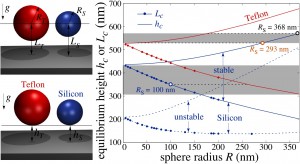Forceful thinking

Calculations indicate it may be possible to use the interplay between the repulsive Casimir force and gravity to create stable nanostructure configurations levitated above dielectric slabs. This plot shows the stable equilibrium center-surface (Lc) and surface-surface (hc) separation between either a Teflon (red) or silicon (blue) nanoparticle and a semi-infinite gold slab. It shows that decreasing R acts to increase the surface-surface separation and decrease center-surface separation. The gray areas depict regions in which the Lc or hc can be made equal by an appropriate choice of radii.
The new algorithms have predicted some surprising quirks. In one case the researchers calculated the force between two metal blocks when two parallel plates are placed above and below them. As the plates move closer to the blocks, the Casimir force between the blocks decreases. At a critical point, however, the force begins to increase. When the plates actually contact the blocks, the force is bigger than when the plates were nowhere near.
“If you apply the intuition people had before, you would predict completely the opposite results,” Rodriguez says. “You would predict the plates would decrease the force between the two blocks.” Researchers are scrambling to understand the results.
The idea to apply FDTD to Casimir force calculations arose from something Rodriguez helped develop, the Casimir analog computer – so-called because it measures a Casimir force-related quantity rather than the force directly. It could calculate the force without supercomputers or experiments involving tiny parts in vacuum chambers.
Because Maxwell’s equations are scale-invariant, there’s a mathematical correspondence between calculating the quantum electromagnetism behind the Casimir force in a vacuum and calculating classical electromagnetic behavior of larger bodies in a conducting fluid such as saltwater, the PNAS paper says. Researchers who want to calculate the force between objects of virtually any shape could scale those objects up to centimeters from nanometers or micrometers.
Fluid situation
The objects would be placed in a conducting fluid and bombarded with microwaves. How the bodies respond should represent how the Casimir force would act on similar bodies at the smaller scale, the researchers say.
Instead of calculating the forces exerted by quantum fluctuations, the researchers compute the strength of an electromagnetic field at various points around the larger objects. That, the MIT team says, puts such calculations within the reach of classical analytical methods available in standard engineering software.
The experiment could allow researchers to repeatedly calculate the Casimir force on complex bodies such as capsules and cubes, Rodriguez says. “You could probably build many different structures easily and run many, many experiments. The sampling rate is much faster.”
Johnson gives Rodriguez and McCauley much of the credit for describing the computer. When the idea came up, “Alejandro got very excited and started talking to everyone. He came back to me a week later and had this whole idea really fleshed out.”
Rodriguez’s work in Casimir forces has created enormous possibilities, Johnson says. “Every time I turn around, Alejandro is calculating another structure or is in another collaboration,” he adds. As of early 2010, Rodriguez had contributed to 25 papers – with lead authorship on 11 – in just three years of graduate school. Four papers appeared in Physical Review Letters; Rodriguez was first author on two of those.
In a paper published in March, the MIT researchers and physicist Michael Levin of Harvard University’s Society of Fellows described an arrangement of materials that enables Casimir forces to cause repulsion in a vacuum. That could open the door to designing MEMS that actually work to keep from sticking.
Some experimental scientists have expressed interest in building the Casimir analog computer. Rodriguez says he’s interested, too.
“I have never in my life had anything to do with experiments, so this is sort of an ambitious goal for me.”
About the Author
The author is a former Krell Institute science writer.




